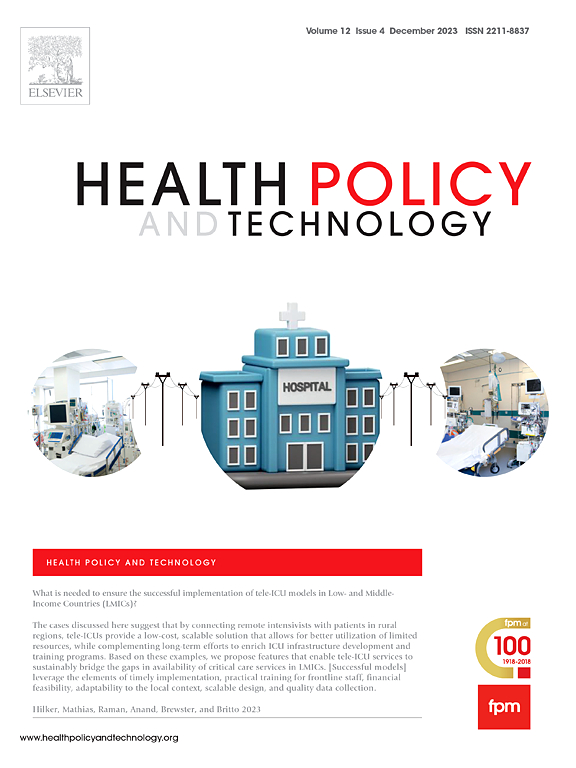电子处方:从孟加拉国的角度看信息和通信技术的实际应用
IF 3.7
3区 医学
Q1 HEALTH POLICY & SERVICES
引用次数: 0
摘要
目的医疗管理机构有责任为患者提供便捷的服务。传统的医疗保健管理系统在很多情况下都是相当陈旧和不切实际的,包括身体检查。再加上新型冠状病毒感染症(COVID-19)的扩散,使现有的制度变得难以实现,这给医生和患者带来了很大的风险。电子处方管理系统可以将现有的电子处方管理系统转换为网上预约和医生咨询系统。许多发达国家已经采用了这种电子处方管理系统,尽管孟加拉国等低收入和中等收入国家对此漠不关心。因此,在包括孟加拉国在内的所有国家实施电子处方管理系统是时间的要求,特别是在掌握信息和通信技术(ICT)的情况下。方法利用最新的软件和web开发工具,设计、开发和测试基于信息通信技术的在线医患管理系统。结果在开发的电子处方管理系统中,患者可以根据自己的需要和医生的空闲时间访问个人档案进行预约。之后,患者根据管理小组批准的预约向医生咨询。最后,患者收到在线电子处方,并从可访问在线电子处方的注册药房取药。电子处方管理系统记录了患者的历史,包括电子处方,使处理患者变得容易。结论开发的电子处方管理系统的正确使用,将解决现有医疗管理系统存在的诸多问题,包括新冠肺炎疫情带来的诸多担忧。本文章由计算机程序翻译,如有差异,请以英文原文为准。
E-Prescription: A practical application of information and communications technology in perspective of Bangladesh
Objectives
The healthcare management authorities are responsible for delivering convenient services to the patients. The traditional healthcare management system is quite old and impractical in many cases, including a physical visit. Additionally, the COVID-19 epidemic makes the existing system unattainable, which creates an uncomfortable situation for visiting doctor's chambers that is risky both for doctors and patients. An electronic-prescription (e-prescription) management system can switch the existing one to the online appointment and doctor consulting system. Many developed countries have already adopted such e-prescription management systems, although low-and-middle-income countries (LMICs) like Bangladesh are apathetic. So implementing e-prescription management systems in all countries, including Bangladesh, is the demand of time, especially when information and communication technologies (ICT) are at hand.
Method
We design, develop and test an ICT-based online doctor and patient management system utilizing the latest software and web development tools.
Results
In the developed e-prescription management system, the patient can visit their profile to make an appointment according to their need and doctor's availability. After that, the patient consults with the doctor based on the appointment's approval by the admin panel. Finally, the patient receives an online e-prescription and collects the medicine from a registered pharmacy with access to the online e-prescription. The e-prescription management system records patient history, including e-prescription, making handling patients easy.
Conclusion
The proper use of the developed e-prescription management system will solve many existing problems of the existing healthcare management system, including many concerns that arise due to the advent of COVID-19.
求助全文
通过发布文献求助,成功后即可免费获取论文全文。
去求助
来源期刊

Health Policy and Technology
Medicine-Health Policy
CiteScore
9.20
自引率
3.30%
发文量
78
审稿时长
88 days
期刊介绍:
Health Policy and Technology (HPT), is the official journal of the Fellowship of Postgraduate Medicine (FPM), a cross-disciplinary journal, which focuses on past, present and future health policy and the role of technology in clinical and non-clinical national and international health environments.
HPT provides a further excellent way for the FPM to continue to make important national and international contributions to development of policy and practice within medicine and related disciplines. The aim of HPT is to publish relevant, timely and accessible articles and commentaries to support policy-makers, health professionals, health technology providers, patient groups and academia interested in health policy and technology.
Topics covered by HPT will include:
- Health technology, including drug discovery, diagnostics, medicines, devices, therapeutic delivery and eHealth systems
- Cross-national comparisons on health policy using evidence-based approaches
- National studies on health policy to determine the outcomes of technology-driven initiatives
- Cross-border eHealth including health tourism
- The digital divide in mobility, access and affordability of healthcare
- Health technology assessment (HTA) methods and tools for evaluating the effectiveness of clinical and non-clinical health technologies
- Health and eHealth indicators and benchmarks (measure/metrics) for understanding the adoption and diffusion of health technologies
- Health and eHealth models and frameworks to support policy-makers and other stakeholders in decision-making
- Stakeholder engagement with health technologies (clinical and patient/citizen buy-in)
- Regulation and health economics
 求助内容:
求助内容: 应助结果提醒方式:
应助结果提醒方式:


